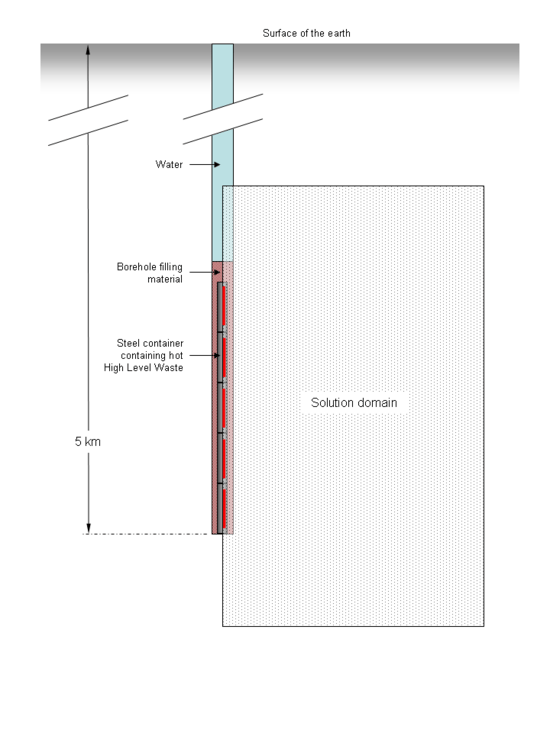Deep borehole disposal
Deep borehole disposal is the concept of disposing of high-level radioactive waste from nuclear reactors in extremely deep boreholes (Deep geological repository). Deep borehole disposal seeks to place the waste as much as five kilometers beneath the surface of the Earth and relies primarily on the thickness of the natural geological barrier to safely isolate the waste from the biosphere for a very long period of time so that it should not pose a threat to man and the environment. The concept was originally developed in the 1970s, but recently a proposal for a first experimental borehole has been proposed by a consortium headed by Sandia National Laboratories.[1]
Illustration
In the diagram the solution domain is used for the purpose of computer modelling of heat flow around the borehole.[2]
 Deep borehole nuclear waste disposal works by drilling deep into the Earth's crust |
Details
The concept involves drilling a borehole about 5 km down into the Earth's crust. High level waste, like spent nuclear fuel, would be sealed in strong steel containers and lowered down the borehole, filling the bottom one or two kilometers of the hole. Current technology limits the diameter of the borehole to less than 50 centimeters. This means that some waste currently stored in large containers would need to be repackaged in smaller containers.[1] The rest of the borehole is then sealed with appropriate materials, including clay, cement, crushed rock backfill, and asphalt, to ensure a low-permeability barrier between the waste and the land surface. In some concepts, waste may be surrounded by cementitious grout or a highly compacted bentonite buffer matrix to provide improved containment and to reduce the effect of rock movement on the canisters' integrity. A high-temperature scenario involves very young hot waste in the containers which releases enough heat to create a melt zone around the borehole. As the waste decays and cools, the melt zone resolidifies, forming a solid granite sarcophagus around the containers, entombing the waste forever.[3] Under both scenarios, chemically reducing conditions adjacent to the borehole will reduce the transport of most radionuclides.
The deep borehole concept can be applied to any amount of waste. For countries that do not rely on nuclear power plants, their entire inventory of high-level nuclear waste could perhaps be disposed of in a single borehole. Current estimates suggest that spent fuel generated from a single large nuclear power plant operating for multiple decades could be disposed of in fewer than ten boreholes. It is estimated that only 800 boreholes would be sufficient to store the entire existing nuclear waste stockpile of the USA.[1] Borehole disposal programs could be terminated at any time with little loss of investment because each borehole is independent. The modular nature of borehole disposal would lend itself to regional, or on-site, disposal of nuclear waste. Another attraction of the deep borehole option is that holes might be drilled and waste emplaced using modifications of existing oil and gas drilling technologies.
Finally, the environmental impact is small. The waste handling facility at the wellhead, plus a temporary security buffer zone, would require about one square kilometer. When the borehole is filled and sealed, the land can be returned to a pristine condition.
References
- ↑ 1.0 1.1 1.2 Tollefson, Jeff (4 March 2014). "US seeks waste-research revival". Nature 507: 15–16. doi:10.1038/507015a. Retrieved 5 June 2014.
- ↑ Viney, Clare (1 June 2007). "Managing our nuclear waste" (6). Royal Society of Chemistry. Retrieved 3 June 2014.
- ↑ University of Sheffield
External links
- Journal of the Geological Society, Jan 2000 by Gibb, Fergus G F
- 2004 Nirex Report : A Review of the Deep Borehole Disposal Concept for Radioactive Waste
- Hoag/MIT Thesis - Canister Design for Deep Borehole Disposal of Nuclear waste
- Sandia National Labs' Performance Assessment of Deep Boreholes
- Sizer/MIT Thesis - Minor Actinide Waste Disposal in Deep Geological Boreholes
- 2010 NEI Deep Borehole Article
- 2010 Physics Today Deep Borehole Article
- March 2010 Driscoll Presentation at Sandia-MIT Borehole Workshop